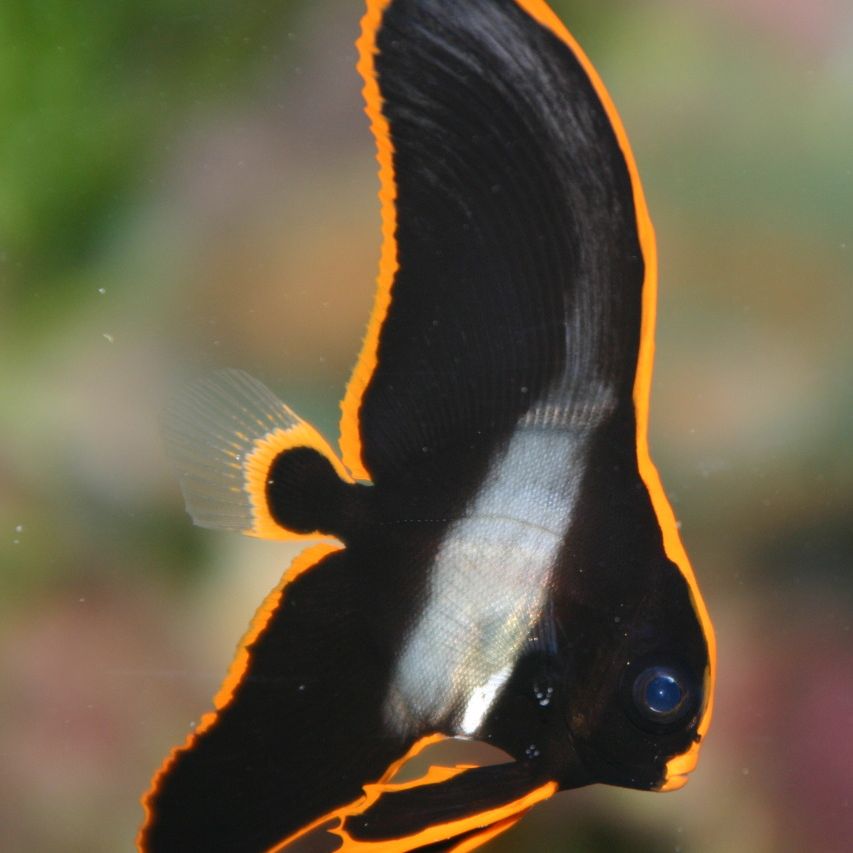
The firebird fish, or Platax pinnatus, is one of those “holy grail” species that captivates home aquarium enthusiasts and professionals alike.
This fish, with its elongated fins that glow like neon fire (hence its most popular common name “firebird fish”), is truly a sight to behold!
This relatively rare species is notoriously challenging (some say “nearly impossible”) to care for in captivity, making it a poor investment for the beginners. For the intermediate to advanced saltwater enthusiasts, however, recent research has made some contributions that could translate into better success over time.
Not surprisingly, the firebird fish price reflects its relative rarity in the pet trade and correspondingly high demand from aquarium owners and breeders.
Contents
Pinnatus Batfish Purchase Price
The firebird fish goes by several common names, including Pinnatus batfish, shaded batfish, longfin batfish, dusky batfish, and red-faced batfish. Unfortunately, it can be very difficult to find an available specimen to purchase even if money is no object!
One posted price at Saltwater Fish for $108.99 demonstrates this – there is currently a waiting list to purchase the next specimen that is available.
Blue Zoo Aquatics has a price menu ranging from $79.95 to $199.95 with a waiting list on all sizes. You will notice there is a restriction on the typical guarantee of live delivery for shipped aquatic species.
Aquarium Creations Online does have some specimens in stock – both wild-caught and captive-bred. The latter is your best bet for the most stable health since this fish has not had to endure transit previously and is used to life in an aquarium environment.
The prices range from $89.99 to $169.99 and here again, there is no initial guarantee of health beyond live arrival so you will be taking a chance with every shipment.
Factors Affecting Firebird Fish Purchase Price
The difficulty of raising this species in captivity means there is a demand for wild-caught firebird fish which, over time, can place stress even on healthy wild populations.
- Supply and demand
By far the most impactful criterion that can affect the price is simply the relationship between the number of available commodity on the market and the number of people who want to buy them.
- High mortality rate.
Another important criterion is the high rate of mortality among captive firebird fish.
Transit is especially stressful for this gentle saltwater fish, which is why most online fisheries will not provide a health guarantee at all or will limit theirs to an initial guarantee of live arrival.
- Age (size)
A healthy captive firebird fish can easily live up to 15 years and grow up to 20 inches long. But if this is your first time keeping a firebird fish, it is important to know that most captive firebird fish live for days or weeks rather than months or years in captivity.
As well, the neon etching along the fins only lasts for a short period of time until the fish matures – at which point their coloration becomes more of a muted silver/gray which remains for the balance of their lifespan.
Most collectors want the juvenile fish for their aquarium which can drive up the price.

One-Time Pinnatus Batfish Costs
Your aquarium setup will be vital for success in keeping your newly acquired Platax pinnatus alive and well. One of the major obstacles to success is that this fish can be a picky eater in captivity which may in part be caused by the stress of transit.
Another challenge is that the firebird fish’s habitat preferences change rather dramatically as this fish matures.
The showy juveniles like shallow water coral reef habitats where food is plentiful and easy to catch. Adults are loners and prefer to live at depths of up to 65 feet below the water’s surface.
- Minimum 300-gallon non-reef tank environment
To successfully keep a captive Platax pinnatus alive, researchers suggest providing a minimum of 300 gallons to minimize stress and maximize free movement.
The tank should have live rock with fish only. The firebird fish will otherwise graze any coral reef clean of small stationary plants and aquatic life.
Prices at Fish Tanks Direct start at $2,800 and up.
- Wet/dry filtration system + carbon filtration + protein skimmer
The wet/dry filtration system is the best to keep nitrate concentration low and water rich with dissolved oxygen. Prices start at $400.
Chemical (carbon) filtration is necessary to break down other impurities that can compromise fish health. Prices start at $340 from Saltwater Aquarium.
A protein skimmer removes phosphates and other compounds that can be toxic to firebird fish. Prices start at $549.
- Aquarium environment, temperature, pH
The temperature should remain between 77° and 80°F (25° to 27° C) with a pH of 8.2 to 8.4. A saltwater aquarium monitoring system is a must to keep the environment hospitable for these finicky fish.
Expect prices starting at $100 and up.
Ongoing Firebird Fish Costs
Appropriate food and peaceful tank mates are key to supporting this species in captivity.
- Food
Dried or fresh seaweed, nutrient-rich dark leafy greens, small prey like ghost shrimp, krill and bloodworms are each essential for daily nutrition.
Krill costs $20 and up for every 3000 ml container. Pelleted food for fish (8 oz.) costs $15. Bloodworms cost a little over $10 per 27g pack while Seaweed costs $14 for 2.56 oz, 50-sheet pack.
- Décor
Firebird fish should only be housed with other peaceful species that will not be tempted to nip at their enticing fins. They need smooth rocks and hiding spots to avoid fin damage. Expect to pay $10 to $16 per rock cave.
Plastic plants should also be smooth and soft. Larger plastic plants start at $15 for a set.
- Veterinary
This species is not hardy in captivity and can easily be impacted by two common fish diseases (ich, marine velvet). Cost of veterinary care typically ranges from $20 to $80.
